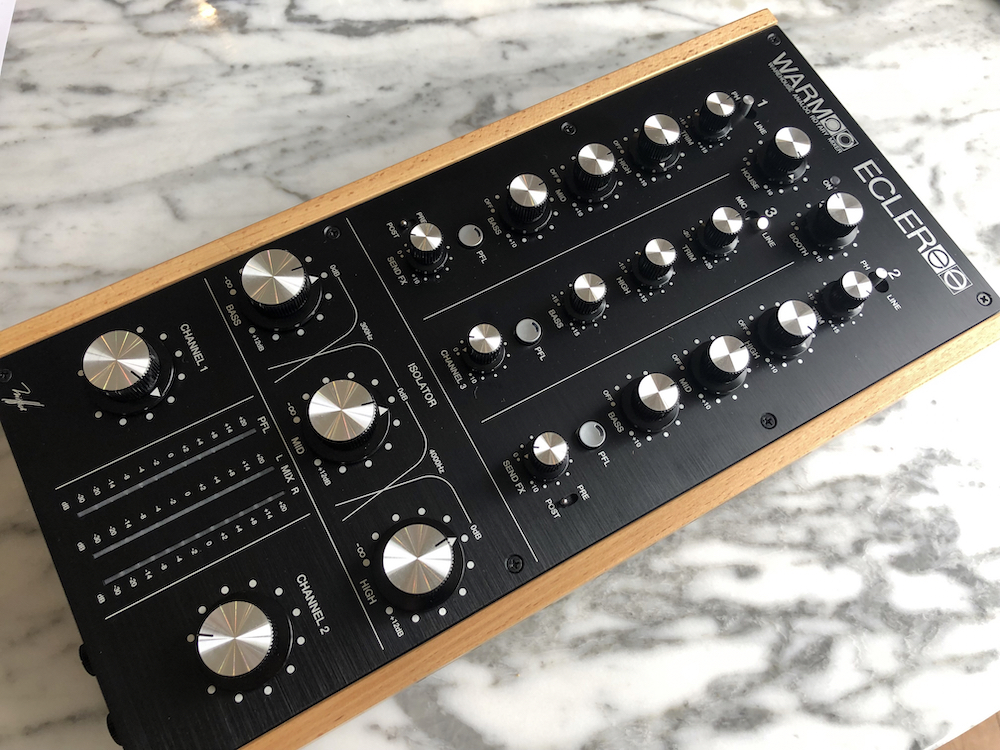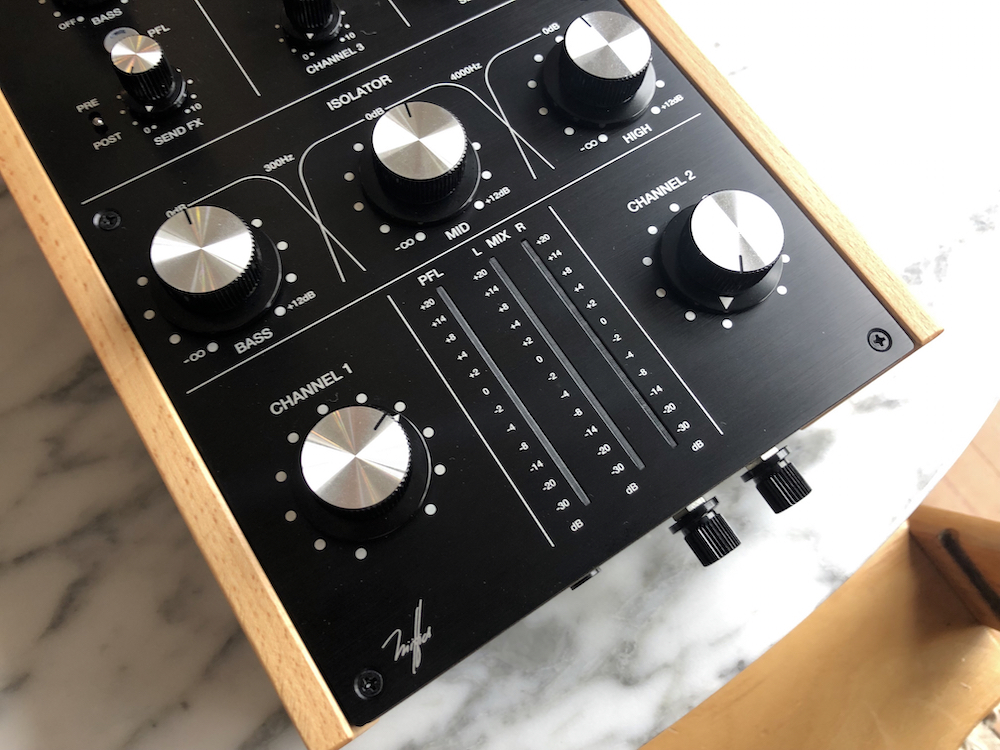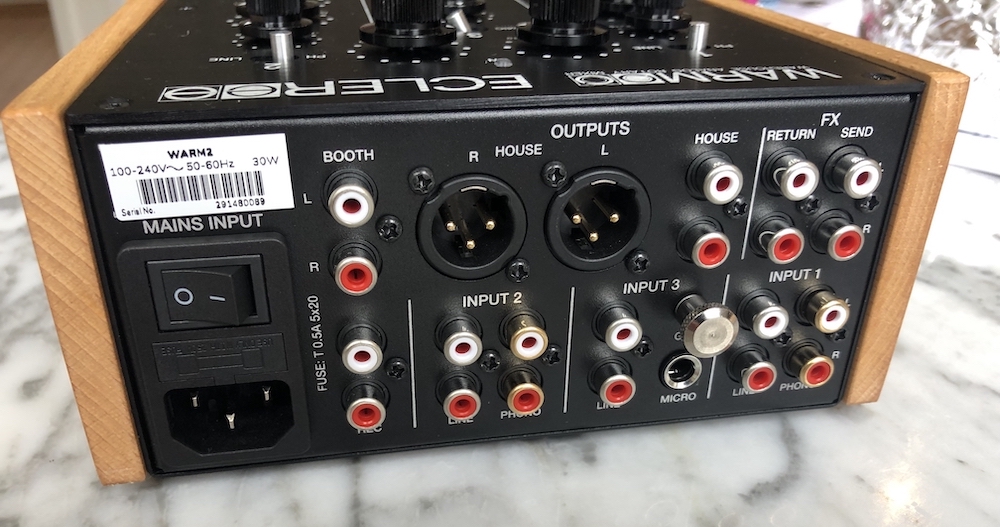The Spanish brand’s first ever rotary mixer promises to bridge the gap between entry-level mixers and audiophile rotary exotica. Greg Scarth finds out whether it can live up to the hype.

Ecler’s product range covers most bases of pro audio-visual equipment, but the Barcelona brand has particularly deep roots in DJ mixers, having produced them since the 1970s. The company’s Nuo 2.0 is a bit of a hidden gem in the entry-level DJ mixer market and the new Ecler WARM2 (Warehouse Analog Rotary Mixer) is essentially the rotary equivalent. It’s a two-channel (or perhaps two-and-a-half-channel) design with built-in three-band isolator, looking to bridge the gap between entry-level rotary options like the Omnitronic TRM-202 MK3 and far more expensive audiophile mixers like the Alpha Recording System Model 1100.
The growth in popularity of rotary mixers could be described as the dictionary definition of exponential. Cult classic brands like Urei and Bozak were favoured by the likes of house legends Larry Levan and Frankie Knuckles, while purists like DJ Harvey and Theo Parrish have kept the faith right through until the recent explosion of new rotary mixer models. Unleashing the WARM2 from its shrinkwrap, first impressions are very good, with nice wooden side panels and a vintage-inspired look. It’s billed as a two-channel mixer, with the two main phono/line channels featuring three-band EQ and large, dedicated volume knobs down at the bottom of the main panel. We say you could describe the WARM2 as a two-and-a-half channel mixer because there’s also a third channel for a line or mic input, which is slightly more simple with just a two-band EQ and small level control rather than a large volume knob in the main section.
As with most rotary mixers, there’s no crossfader here; you mix solely using the large volume knobs, blending new tracks in with a twist of the knob rather than a crossfader. The three-band isolator section above the main level controls is also a crucial element, allowing you to sculpt and shape the tone of the main output to balance the sound or perform more extreme effects like dropping frequencies out of the mix. All in all, it’s a pretty classic setup for a modern take on a retro rotary mixer.

Build quality is generally very good. The whole unit feels nicely weighty and well constructed, with quality components and a good finish. Key potentiometers (the electronic components behind the five main controls for the isolator and channel 1/2 level) are Alps Blue Velvet, the same as you’d find in plenty of exotic audiophile mixers. Controls have an extremely solid feel with the exception of a couple of the smaller knobs for channel 3, which feel slightly lighter presumably due to some kind of construction difference. Around the back of the unit, the inputs and outputs are pretty much as you’d expect: line and phono inputs over RCA sockets, master outputs over balanced XLR or unbalanced RCA, plus an effects loop, booth and record outputs all over RCA. All simple and easy to hook up to your chosen media players, CDJs, turntables and sound system.

In use, there are no surprises about the functionality of the WARM2 itself. Rotary mixers can be quirky in some cases. A few of the more vintage-inspired models do things in odd ways which can make the learning curve steep for anyone making the move from more conventional mixers, but that shouldn’t be a concern here. Whether you’re a newcomer to DJing, experienced with other mixers or even a rotary aficionado, you’ll soon get comfortable with the layout and features. Cueing channels in your headphones is controlled via the PFL (pre-fade listen) buttons underneath each channel strip, and there’s a dedicated level meter for the pre-fade signal so that you can set your levels using the channel trim pots. There’s an effects send loop for each of the main channels, which can be switched independently to pre- or post-fade levels. All in all, it’s simple to use with no idiosyncrasies to speak of.
In terms of sound, the WARM2 is a clear step above the slightly more prosaic TRM-202. It’s not on the level of hand-built audiophile exotica like the ARS mixers, but it’s very impressive for this price point. There’s a subtlety to the EQ and a synergy with the volume controls which not only sounds good but encourages you to mix differently. There’s a certain type of DJ who favours a rotary mixer and a certain type of mixing style which goes with that. Rotary mixers like the WARM2 don’t lend themselves to fast cuts and surgical EQ tweaks for obvious reasons – the absence of a crossfader, the natural instinct to twist a large volume knob slowly rather than slamming up a straight fader. The benefits of the approach reveal themselves when you start mixing on the WARM2, with the curves of the volume pots lending themselves to longer, slower blends. That in turn inspires certain musical selections; it’s fair to say that rotary mixers aren’t the obvious choice for techno or drum’n’bass, but instead we’re largely talking deep house and classic disco here, plus more eclectic selectors who might want to introduce the odd bit of jazz, Balearic, funk and soul into their sets.

Overall, the WARM2 is an instant hit. A lot of the classic benefits of rotary mixers aren’t necessarily reflected in specifications, but it’s impressive that the WARM2 matches and even beats the features of more expensive options. Ergonomics play a major part in the appeal, but it’s all about the balance between features and functionality. With the WARM2, you also get the convenience you’d expect from modern mixers, with details like the dual 3.5mm and ¼-inch headphone sockets on the front panel, meaning you’ll never need an adapter. Metering on the WARM2 is also particularly good, with a single strip of LEDs for the pre-fade listen (cue) channel and stereo metering for the master output. It’s a mixer which will appeal to lots of people not just because it’s relatively cheap as far as rotary mixers are concerned, but also because it’s a very good example. Get your hands on one and you’ll quickly see why rotary mixers have remained cult favourites for so long.
Greg Scarth
More info/buy